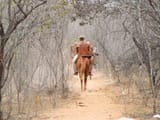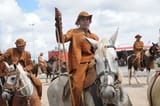>>213441964
The Northeastern vaqueiro is known for his endurance and skill in handling cattle in the caatinga. Unlike American cowboys, who use lassoes to capture the steers, the Brazilian vaqueiro throws himself at the animals, controlling them with his bare hands. This practice requires courage and extensive knowledge of the terrain.
A distinctive feature is the traditional leather clothing, which protects the vaqueiro from the thorns of the dry vegetation and the charging of the steers. The complete outfit includes a hat, leggings, jerkin, and boots, elements that are part of the Northeastern vaqueiro's visual identity.
The vaqueiro culture is present in various cultural expressions, from music to traditional festivals. The Vaquejada, for example, is one of the most popular events in the Northeast, bringing together vaqueiros from different regions in competitions that involve strength and skill to bring down the steer within a demarcated area.
Beyond competitions, cordel literature and folk songs celebrate stories of bravery and the challenges faced in the backlands. The vaqueiro is also featured in religious festivals, such as the Vaqueiro Mass, a celebration that honors these workers and strengthens the bond between faith and tradition in the Northeastern countryside.



